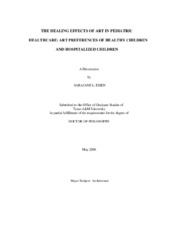| dc.description.abstract | Art is assumed to possess therapeutic benefits of healing for children, as part of patient-focused design in healthcare. Research on adult patients suggests that by infusing art into the healthcare setting, the design may reduce stress that could impede the healing process. Since the psychological and physiological well-being of children in healthcare settings is extremely important in contributing to the healing process, it is vitally important to identify what type of art supports stress reduction. Nature art was anticipated to be the most preferred and have stress-reducing effects on pediatric patients. The objective of this study was to investigate what type of art children prefer, and what type of art has potentially stress-reducing effects on pediatric patients. This study used a three-phase, multimethod approach: a focus group study, a randomized study, and a quasi-experimental study design. Findings from three phases were evaluated. The objective of Phase 1 was to discern what type of art school children prefer, Phase 2 focused on what type of art hospitalized children prefer and to compare these preferences identified in Phase 1. Phase 3 was a quasi-experimental study to determine if nature art has a potentially healing effect on pediatric patients when compared to abstract art or no art at all. The findings of this study demonstrate that nature art is the preferred type of art by children from age 5 to 17. But there were no significant differences among the three art intervention groups of pediatric patients. These findings led to design recommendations regarding what art should be placed in children'€™s hospital rooms in order to create a stress-reducing, healing environment. | en |


